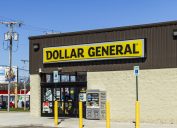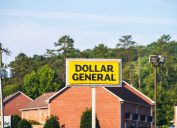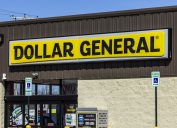Dollar General's Unsafe Store Conditions Are "Severe," Labor Department Warns
They say the company has willfully and repeatedly violated safety standards.
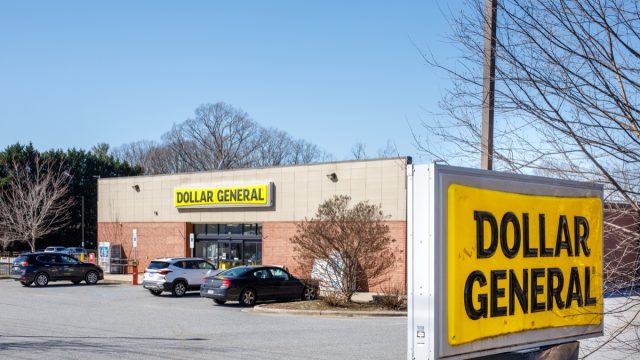
Dollar General has become a major presence in the U.S. The discount chain is set to open over a 1,000 new stores this year—making it one of the fastest expanding retailers in the entire country. But as helpful as it is to have more discount stores to shop at during a time in which prices are still relatively high, Dollar General's expansion may actually be more hurtful than anything. The Labor Department is now deeming the retailer as a "severe violator" of safety standards. Read on to find out more about why Dollar General is being called out for unsafe store conditions.
READ THIS NEXT: Communities Are Fighting Back Against Dollar General and Dollar Tree—Here's Why.
The Labor Department recently ramped up its enforcement for safety standards.

The U.S. Department of Labor's Occupational Safety and Health Administration (OSHA) initially introduced its Severe Violator Enforcement Program (SVEP) in 2010. But new changes were made to this program in Sept. 2022 in an effort to "strengthen enforcement and improve compliance" with safety standards. With this, the department updated the criteria that allows an employer to be placed in the SVEP for willful or repeated violations.
"The Severe Violator Enforcement Program empowers OSHA to sharpen its focus on employers who—even after receiving citations for exposing workers to hazardous conditions and serious dangers—fail to mitigate these hazards," OSHA's Assistant Secretary Doug Parker said in a statement. "Today's expanded criteria reflect the Biden-Harris administration's commitment to ensuring OSHA has the tools it needs to ensure employers protect their workers or hold them accountable when they fail to provide safe and healthy workplaces."
Dollar General has now been deemed a "severe violator."

The new criteria put in place by OSHA last fall has shined a bad light on Dollar General. The discount retailer is the first company to be added to the SVEP under its expanded range, The New York Times reported on March 28. According to the newspaper, data provided by a White House official indicates that OSHA has inspected more than 270 Dollar General stores since 2017. Out of these inspections, the agency has found 111 instances of workplace safety violations and imposed over $15.5 million in penalties because of them.
Over the past three months alone, several Dollar General stores in Ohio, Florida, Alabama, and Georgia have been cited by OSHA for hazards in stores. These include—but are not limited to—obstructed exit routes, blocked fire extinguishers, cluttered aisles, and boxed stack in an unsafe manner. "What we have found time and time again at Dollar General stores is that there are obvious, preventable hazards that are putting workers at risk," Parker told The New York Times.
RELATED: For more up-to-date information, sign up for our daily newsletter.
Officials say hazards at the retailer's stores often go unfixed.

It's not just that OSHA has found several Dollar General stores violating safety standards. Two federal officials (who asked to remain anonymous) told The New York Times that in some cases, inspectors have demanded hazards be fixed only to return to one of the retailer's stores in a follow-up visit to find the problem was still there. According to the officials, Dollar General has been unwilling to engage with OSHA about resolving these issues in a broad manner up until recently—often contesting many of the penalties, instead.
"I am glad OSHA is not waiting for a tragedy to occur to document these hazards. But at the same time what is being revealed by the numerous OSHA inspections and mounting fees is that Dollar General doesn't care," Joseph McCartin, a labor historian at Georgetown University, told The New York Times. "When you have corporate scofflaws, which Dollar General has shown itself to be, the system needs to be strengthened."
According to Parker, Dollar General has created a business model that lends itself to potential hazards. The retailer operates lightly staffed and small-scale stores that have a high sales volume. So, there are often not enough employees present to unload delivery trucks and immediately stock shelves, which means inventory often lingers in the aisles creating potential hazards for both workers and customers.
Dollar General said it is regularly reinforcing its safety expectations.
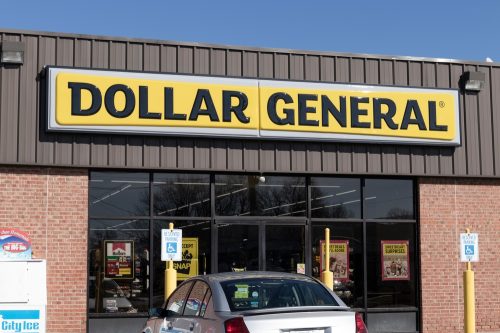
Best Life has reached out to Dollar General about being added to the enforcement program and we will update this story with their response. But according to The New York Times, the retailer is now in the very early stages of discussing settlement possibilities with OSHA. The two federal officials said that Dollar General is looking its resolve the penalties and come up with plan to improve the unsafe conditions in its stores.
Dollar General did not comment on these settlement discussions, but the company told The New York Times that they "regularly review and refine our safety programs, and reinforce them through training, ongoing communication, recognition, and accountability." Dollar General added in its statement to the newspaper, "When we learn of situations where we have failed to live up to this commitment, we work to timely address the issue and ensure that the company's expectations regarding safety are clearly communicated, understood, and implemented."
